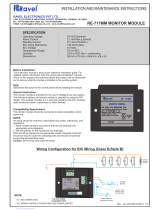
13
AFC-100 INSTALLATION MANUAL-5403648-REV H 10/22
PAD100-SLCE/SLCE-127
The panels can be programmed to support one PAD100-SLCE (PAD protocol) or one SLCE-127 (Nohmi protocol)
loop expander if the built-in SLC loop is disabled. The expansion cards support up to 100 addressable points. The
expansion cards support both Class B and Class A wiring.
Remote Annunciator/Keypad Circuits (RA-6500R, RA-6500F, RA-6075R)
A maximum of 31 annunciators in any combination may be connected to the main re control panel. The RA-
6500R and RA-6500F provide a 4x40 character LCD display, along with standard function and numeric keys. The
RA-6075R provides a 2x16 character LCD, along with standard function and numeric keys.
UD-1000/UD-2000
The panel can be programmed to support the UD-1000/UD-2000 digital alarm communicator transmitter (DACT).
The DACT may be enabled, disabled or bypassed depending on the mode of operation. When the DACT is
disabled, the panels are not capable of transmitting any alarms o premises through the DACT.
The DACT provides for up to two phone lines for communication to a monitoring station. The DACT
communicates using the SIA-DCS or Ademco Contact ID protocols. When enabled, the DACT automatically
monitors each phone line or voltage and has the ability to seize the line and connect with a remote receiver. Once
the communication is complete, the DACT will hang up the phone line.
The UD-1000 is provided with an RJ-11 jack for each phone line. The UD-2000 is provided with terminal
blocks for each phone line connection. In order for the DACT to work properly, it must be installed on a plain
old telephone service (POTS) or equivalent as deemed by the authority having jurisdiction. The DACT must be
installed before any other equipment to ensure it can seize the line and disconnect any other lines.
Phone lines are high voltage and should be run in a separate conduit from other circuits. The wire conductors
connecting the DACT to the phone system should be 26 AWG or larger.
LED-16/LED-16F (LED Annunciator)
The panel can be programmed to support up to 10 total LED-16/LED-16F and/or DRV-50 modules. Each LED-16/
LED-16F can display alarm/supervisory/trouble conditions for up to 16 zones. Each LED is assigned to a zone,
when that zone becomes active, the LED will illuminate. Five (5) non-programmable system LEDs are also
provided, which annunciate the overall system condition (Power, Earth, Silenced, Alarm, Supervisory & Trouble).
DRV-50 (LED Driver)
The panel can be programmed to support up to 10 total DRV-50 and/or LED-16/LED-16F modules. The DRV-50
has 50 LED outputs that can be individually mapped to any zone. The DRV-50 also has four (4) programmable
supervised dry contact inputs, and ve (5) non-programmable system LED outputs, which annunciate the overall
system condition (Power, Earth, Silenced, Alarm, Supervisory, & Troubles).
RLY-5 (Relay Board)
The panel can be programmed to support up to 31 RLY-5 modules. The RLY-5 provides 5 Form-C relay outputs
which can be individually mapped to any zone. The Relays have a contact rating of 24VDC / 3.0A, 125VAC / 3A,
and Power Factor of 1.0. These outputs are non-power limited and not supervised.
Note: If the power supply connected to the relays is power-limited, then the outputs are power limited.
FCB-1000 (Fire Communications Bridge)
The panels support one FCB-1000. The FCB-1000 provides a remotely-located IP connection into the panel. All
IP reporting can be designated to pass through the FCB-1000 instead of through the on-board internet connection.
FIB-1000 (Fiber Interface Bridge)
The panels support up to 31 FIB-1000s. The FIB-1000 can be used to convert the standard 4 wire P-Link bus to/






















